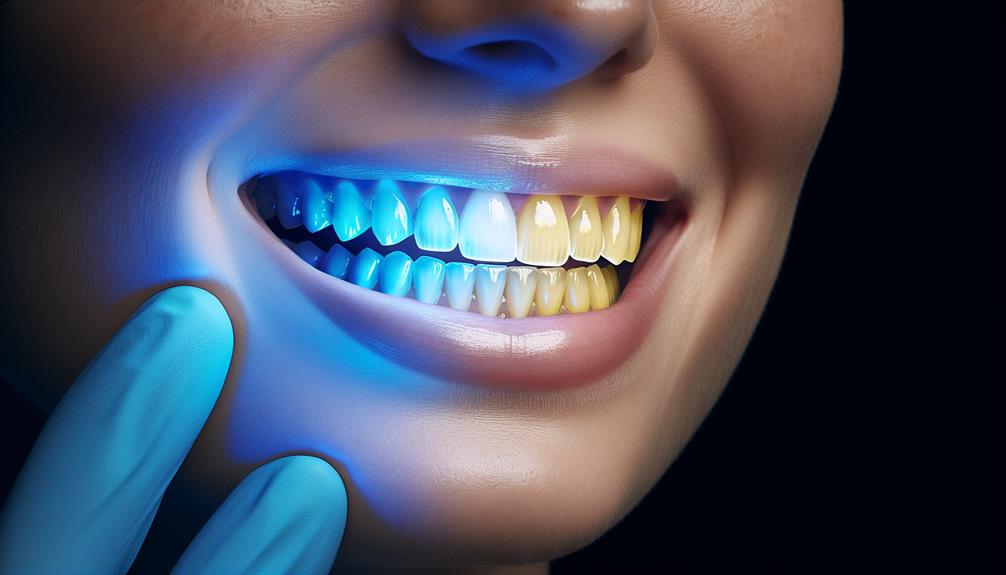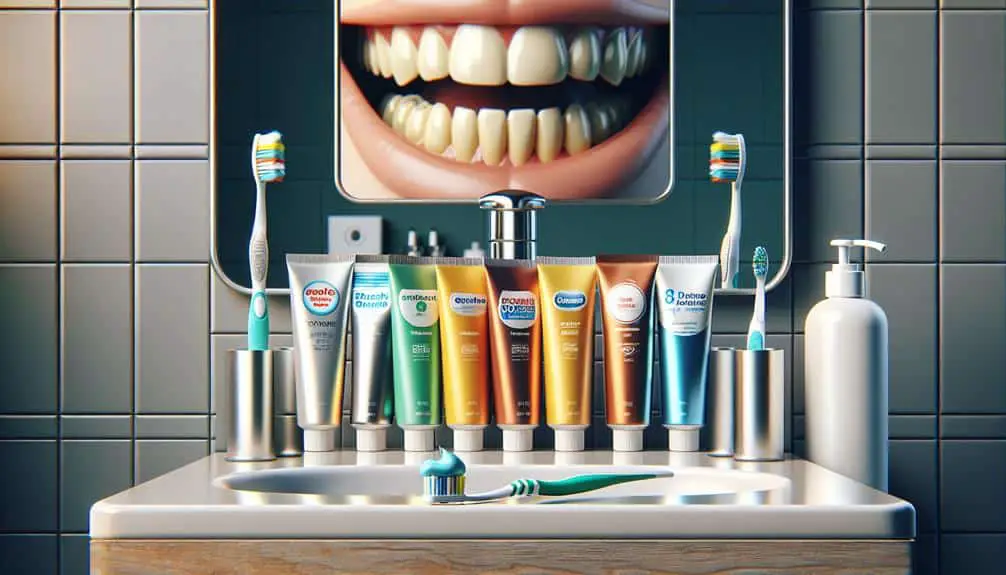Guarantee your yellowed smile transforms into a vibrant white one with the seven best blue light methods for teeth whitening. Blue light enhances whitening efficiently, reduces sensitivity, and accelerates the process. This method penetrates enamel effectively, providing longer-lasting results. To guarantee safe and effective outcomes, use protective eyewear, stick to recommended treatment times, and adjust the light intensity properly. By following expert tips and post-treatment care guidelines, you can maintain your white smile. Get ready for a dazzling smile with these techniques designed for efficient and long-lasting results.
Key Points
- Blue light accelerates whitening process effectively.
- Enhances whitening agent for deeper results.
- Ensures longer-lasting, sustainable white smile.
- Penetrates enamel efficiently for optimal whitening.
- Delivers efficient and safe teeth whitening solution.
Benefits of Blue Light Teeth Whitening
When considering teeth whitening methods, the benefits of using blue light technology are significant in enhancing the whitening process efficiently and effectively. Blue light teeth whitening is a popular choice due to its ability to accelerate the whitening process. One major advantage is its potential to reduce tooth sensitivity commonly associated with other whitening methods. The use of blue light helps to minimize discomfort during and after the treatment, making it a more comfortable experience for individuals with sensitive teeth.
Another key benefit of blue light teeth whitening is the reduced treatment frequency required to achieve desired results. The powerful blue light technology enhances the effectiveness of the whitening agents, allowing for quicker and more noticeable results in fewer sessions compared to methods without this technology. This not only saves time but also minimizes the potential risks associated with over-treating teeth.
How Blue Light Works for Whitening
When it comes to teeth whitening, understanding how blue light works can be essential.
The blue light activates the whitening agent, speeding up the chemical reaction that breaks down stains on your teeth.
This process enhances the whitening effects, giving you a brighter smile in a shorter amount of time.
Blue Light Activation Process
The Blue Light activation process accelerates the teeth whitening procedure by enhancing the effects of the whitening agent. Light intensity levels play an important role in this process, as the ideal intensity guarantees the activation of the whitening agent without causing harm to the teeth or gums.
Typically, the treatment duration ranges from 15 to 30 minutes, depending on the specific product used and the desired level of whitening. The Blue Light works by activating photo-activated molecules within the whitening gel, speeding up the chemical reaction that breaks down stains and discoloration on the teeth's surface.
This process is efficient and safe when performed under professional supervision, leading to noticeably whiter teeth in a shorter time frame.
Benefits of Blue Light
To understand the benefits of Blue Light in teeth whitening, it's essential to grasp how this technology functions to enhance the whitening process efficiently and effectively.
Blue light benefits the teeth whitening process through the following:
- Accelerated Whitening: Blue light activates the whitening agents in the gel, speeding up the chemical reaction that breaks down stains on the teeth.
- Deeper Whitening: The blue light can penetrate the enamel, reaching stains that may be difficult to remove with just the whitening gel alone.
- Longer Lasting Results: By using blue light in the whitening process, the results tend to last longer compared to traditional methods, providing a more sustainable white smile.
Comparison With Traditional Whitening Methods
Comparing blue light teeth whitening methods with traditional whitening techniques reveals significant differences in efficacy and speed of results. When it comes to cost comparison and effectiveness analysis, traditional whitening methods such as whitening toothpaste or whitening strips are generally more affordable upfront but may require more frequent purchases to maintain results. On the other hand, blue light teeth whitening may have a higher initial cost but can provide more noticeable results in a shorter amount of time.
In terms of time-saving benefits, blue light teeth whitening surpasses traditional methods by delivering quicker results. The powerful combination of the whitening gel and blue light technology accelerates the whitening process, making it an efficient option for individuals looking for rapid improvements in tooth color. Additionally, the longevity of results with blue light teeth whitening is often greater compared to traditional methods, offering a more prolonged period of whiter teeth before needing touch-ups. When considering these factors, blue light teeth whitening stands out as a compelling choice for those seeking effective and efficient teeth whitening solutions.
Safety Measures for Blue Light Treatment
When considering blue light teeth whitening methods, ensuring safety measures for the blue light treatment is essential for effective and risk-free results. To achieve the best outcomes and protect your oral health during blue light whitening sessions, follow these safety precautions:
- Use Protective Eyewear: Blue light emitted during teeth whitening procedures can be harmful to your eyes. Wearing protective eyewear shields your eyes from the intense light and reduces the risk of any potential damage.
- Protect Your Gums: Safeguarding your gums is vital during blue light treatment to prevent any irritation or sensitivity. Applying a protective gel or barrier along the gum line helps to shield them from the whitening agents and the light.
- Follow Recommended Treatment Times: Adhering to the recommended treatment times is crucial for achieving safe and effective results. Overexposure to the blue light can lead to tooth sensitivity and gum irritation, so it's important to follow the guidelines provided by your dental professional diligently.
Preparing for Blue Light Whitening Sessions
Before commencing your blue light teeth whitening session, make sure that the equipment setup is correct to maximize the effectiveness of the treatment.
Remember to take into account safety precautions such as wearing protective eyewear to shield your eyes from the bright light.
Additionally, adhere to the recommended timing and duration guidelines provided by the dental professional for best results and minimal risks.
Equipment Setup Tips
To optimize the effectiveness of your blue light teeth whitening sessions, make sure your equipment setup is meticulously organized and ready for use. Here are three key equipment setup tips to guarantee your sessions run smoothly and efficiently:
- Proper Positioning: Position the blue light device at the correct angle and distance from the teeth to ensure proper exposure and coverage, leading to effective results.
- Optimal Settings: Set the blue light device to the recommended settings based on the whitening product being used for successful treatment outcomes.
- Preparation: Confirm all necessary tools and materials are within reach, such as protective eyewear for both you and the patient, to streamline the whitening process and maximize productivity.
Safety Precautions to Consider
Make sure you have carefully reviewed and implemented all safety precautions before conducting blue light teeth whitening sessions to safeguard both yourself and your patients.
Prior to the treatment, consider pre-treatment factors such as evaluating the oral health of the patient to guarantee they're suitable candidates for the procedure.
Additionally, it's vital to follow protective eyewear precautions to shield your eyes from the bright blue light emitted during the whitening process. Investing in high-quality protective eyewear can prevent potential damage to your eyes from the intense light exposure.
Timing and Duration Recommendations
Establish that you determine the best timing and duration for blue light teeth whitening sessions to maximize effectiveness and achieve desired results. When it comes to optimizing your teeth whitening routine, timing and duration play pivotal roles. Here are three key considerations to keep in mind:
- Optimal Timing: Choose a time when you can dedicate your full attention to the whitening session without interruptions.
- Effective Duration: Follow the recommended duration provided by the teeth whitening product or your dental professional to guarantee safe and efficient results.
- Consistency is Key: Maintain a consistent schedule for your whitening sessions to enhance the effectiveness of the blue light treatment over time.
Post-Treatment Care and Maintenance
Proper maintenance after undergoing blue light teeth whitening treatment is essential for ensuring long-lasting results and a bright smile. To maintain your newly whitened teeth, establish post-care routines and maintenance practices.
First and foremost, avoid foods and beverages that are known to cause discoloration and stains, such as coffee, tea, red wine, and dark sodas. If you do consume these items, consider using a straw to minimize contact with your teeth. Additionally, practice good oral hygiene by brushing your teeth at least twice a day and flossing daily to prevent plaque buildup, which can contribute to discoloration.
Regular dental check-ups are vital for maintaining your whitened smile. Your dentist can provide professional cleanings and advice on how to best care for your teeth post-whitening. It's also recommended to touch up your whitening treatment periodically to combat any new stains that may develop over time.
Expert Tips for Long-lasting Results
To maintain the longevity of your teeth whitening results, incorporating expert recommendations into your oral care routine can greatly enhance the lasting effects of the treatment. Here are three essential tips to help you achieve long-lasting results:
- Diet Impact on Longevity: Consuming foods and beverages that stain teeth, such as coffee, red wine, and berries, can diminish the effects of teeth whitening. Opt for a teeth-friendly diet rich in fruits and vegetables like apples, carrots, and broccoli, which can help scrub away stains naturally.
- Lifestyle Maintenance for Longevity: Avoid habits like smoking and using tobacco products, as they can cause teeth to yellow quickly. Additionally, practicing good oral hygiene, including regular brushing, flossing, and dental check-ups, can prolong the effects of your teeth whitening treatment.
- Precautions for Long-lasting Results: Consider using a whitening toothpaste or mouthwash to maintain the brightness of your smile. However, be cautious not to overuse these products, as excessive whitening can lead to tooth sensitivity and enamel damage.
Frequently Asked Questions
Are There Any Specific Dietary Restrictions to Follow Before or After a Blue Light Teeth Whitening Session?
Before or after a blue light teeth whitening session, remember to follow specific dietary restrictions. Pre-treatment precautions help maximize results, while post-treatment care guarantees lasting effects. Be mindful of what you eat and your lifestyle habits for best outcomes.
Can Blue Light Teeth Whitening Be Used on Sensitive Teeth or Individuals With Gum Disease?
For individuals with sensitive teeth or gum disease, blue light teeth whitening can be safe and effective. However, it's wise to consult with a dental professional to confirm it's appropriate for your specific condition.
How Long Does the Whitening Effect of Blue Light Treatment Typically Last?
To maintain long term results from blue light treatment, regular maintenance is crucial. The effects on enamel can vary, so it is important to consult with a dental professional for personalized advice on how to preserve your whitening effects.
Are There Any Potential Side Effects or Risks Associated With Blue Light Teeth Whitening?
When considering blue light teeth whitening, it's important to be aware of potential risks. While benefits include enhanced results, safety precautions like protective eyewear are essential. Prioritize safety to maximize the whitening outcome.
Can Blue Light Teeth Whitening Be Used on Dental Restorations Such as Crowns or Veneers?
When considering blue light teeth whitening on dental restorations like crowns or veneers, it's important to know compatibility. Consult your dentist to confirm the treatment won't impact them. Regular maintenance and professional guidance are essential.
Conclusion
So, next time you look in the mirror, imagine seeing a dazzling smile that shines as bright as a starlit sky. With the power of blue light teeth whitening, achieving pearly whites is easier than ever.
Remember to follow safety measures, prepare for your sessions, and maintain your results for a long-lasting smile that sparkles like the ocean on a sunny day.
Say goodbye to yellow teeth and hello to a radiant smile that lights up the room.



